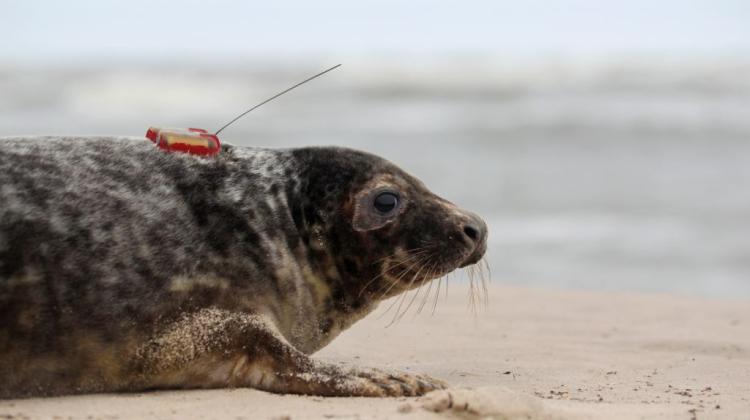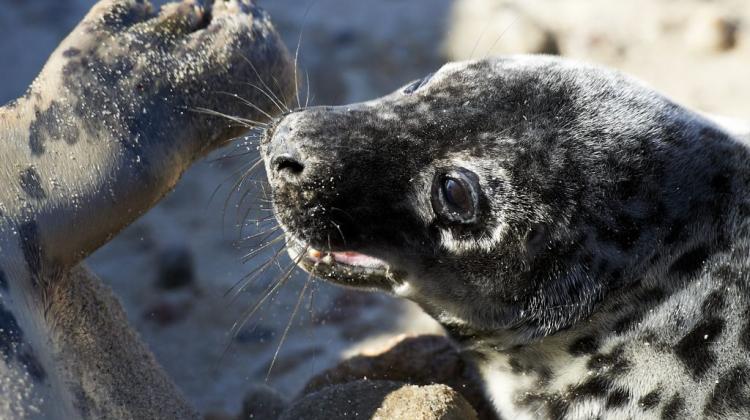Three seals from the Hel sealarium released into the Baltic Sea

Maszop, Maszoperia and Łebek - these are the names of three young grey seals that grew up in the seal nursery in the Hel Marine Station, and were released into the Baltic Sea. They are equipped with transmitters allowing to track their sea journey.
Employees Hel sealarium released the seals on May 27 on the beach near Smołdzino, Słupsk district. All seals willingly went into the sea. The animals arrived in special wooden boxes, and the car carrying them was moving very slowly, not to stress the young animals.
Two of the seals released into the wild were born in seal nursery in the Hel Marine Station of the University of Gdańsk. The young, born in March, are the offspring of permanent residents of the sealarium: females Ewa and Ania. Seal puppies have were named Maszoperia (group of fishermen fishing together in the Baltic Sea - PAP) and Maszop (a member of such group - PAP). After the birth, seals weighed about 17 kg. Now Maszoperia weighs 49 kg, and Maszop - 46 kg.
In April, the seal offspring in Marine Station were joined by pup seal found on the beach near Łeba. The seal’s condition alarmed the sealarium staff so much that they decided to take it under care. The seal weighed just over 15 kg, and now its weight is doubled.
When the seals grow up, they will reach weight of 100-200 kg for females and 200-300 kg for males.
Before releasing them into the wild, the Station staff slowly taught the animals to search and hunt fish. "The seals will have to develop these skills themselves in the wild. In artificial conditions, we are not able to teach them to hunt for herring, which is their main food" - said in an interview with PAP Prof. Krzysztof Skóra, head of the Marine Station in Hel.
Maszop, Maszoperia and Łebek are fitted with transmitters that will allow to track their journey. Devices are attached to the skin of animals by means of a special adhesive. Batteries will power the transmitters for about eight months. "The time of operation depends largely on the activity of seals, including frequency of surfacing, because this is when the device sends data, which requires the use of energy" - said Skóra.
He explained that the information obtained via the transmitters will allow researchers to deepen the knowledge of grey seals, including their migration routes, places where they prefer to feed and rest, or the speed at which they move. "With information from the transmitters, which we attached to our previous animals, we know for example that the seal can cover the distance of 110 kilometres in one day" - said Skóra.
Internet users can follow the journey of young seals at http://wedrowkifok.wwf.pl
The animals released on Tuesday were not the first young seals that went to sea as part of the project of grey seals reintroduction to the southern coast of the Baltic Sea, carried out jointly by the Marine Station and the WWF Polska. This project aims to restore local colonies of this species, once common in our shores.
For a few years, WWF Polska has been running another project in consultation with the Marine Station, called Blue Patrol. In the project, trained volunteers living on the Polish Baltic coast, patrol designated beach sections throughout the year and, if necessary, intervene when they find a seal that needs help.
Members of the WWF also request that anyone who sees these marine animals calls Blue Patrol at 795 536 009, or the UG Marine Station in Hel (phone no. 601 889 940). "Under no circumstances should the seal be approached. Leave it alone, and watch it from afar" - advise the members of the organization.
One hundred years ago there were 100,000 grey seals in the Baltic Sea. In the 1980s there were only 4.5 thousand. At this point, seals were covered by legal protection. The increasing trend of the Baltic grey seal population has been observed since 2000, when 10 thousand animals were counted in the Baltic. During the annual counting of these marine mammals in 2013, nearly 30 thousand grey seals were spotted. Most of them, more than 10 thousand, live in the area of the islands of central Sweden.
PAP - Science and Scholarship in Poland
aks/ agt/ mrt/
tr. RL
Przed dodaniem komentarza prosimy o zapoznanie z Regulaminem forum serwisu Nauka w Polsce.

















